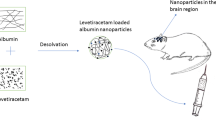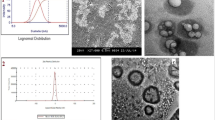Abstract
Purpose. To investigate the possibility of delivering of anticancer drugs into the brain using colloidal carriers (nanoparticles).
Methods. Rats obtained 5 mg/kg of doxorubicin by i v. injection in form of 4 preparations : 1. a simple solution in saline, 2. a simple solution in polysorbate 80 1% in saline, 3. bound to poly (butyl cyanoacrylate) nanoparticles, and 4. bound to poly(butyl cyanoacrylate) nanoparticles overcoated with 1% polysorbate 80 (Tween® 80). After sacrifice of the animals after 10 min, 1, 2, 4, 6, and 8 hours, the doxorubicin concentrations in plasma, liver, spleen, lungs, kidneys, heart and brain were determined after extraction by HPLC.
Results. No significant difference in the body distribution was observed between the two solution formulations. The two nanoparticle formulations very significantly decreased the heart concentrations. High brain concentrations of doxorubicin (>6 μg/g) were achieved with the nanoparticles overcoated with polysorbate 80 between 2 and 4 hours. The brain concentrations observed with the other three preparations were always below the detection limit (< 0.1 |μg/g).
Conclusions. The present study demonstrates that the brain concentration of systemically administered doxorubicin can be enhanced over 60-fold by binding to biodegradable poly(butyl cyanoacrylate) nanoparticles, overcoated with the nonionic surfactant polysorbate 80. It is highly probable that coated particles reached the brain intact and released the drug after endocytosis by the brain blood vessel endothelial cells.
Similar content being viewed by others
REFERENCES
N. H. Greig, Drug delivery to the brain by blood-brain barrier circumvention and drug modification, in: E. A. Neuwelt (ed.), Implications of the Blood-Brain Barrier and Its Manipulation, Plenum Press, New York, 1994, pp. 311–357
E. A. Neuwelt, P. A. Barnett, K. E. Hellstrom, L. Hellstrom, C. L. McCormick, and F. L. Ramsey. Effect of blood-brain barrier disruption on intact and fragmented monoclonal antibody localization in intracerebral lung carcinoma xenografts. J. Nucl. Med. 35:1831–1841 (1994).
E. Bigon, E. Boarato, A. Bruni, A. Leon, and G. Toffano. Pharmacological effects of phosphatidylserine liposomes: regulation of glycolysis and energy level in brain. Br. J. Pharmacol. 66:167–174 (1979).
M. Naoi and K. Yagi. Incorporation of enzyme through blood brain barrier into the brain by means of liposomes. Biochem. Int. 1:591–596 (1980).
F. Umezava and Y. Eto. Liposome targeting to mouse brain: Mannose as a recognition marker. Biochem. Biophys. Res. Commun. 153:1038–1044 (1988).
W. M. Pardridge. Recent developments in peptide drug delivery to the brain. Pharmacol. Toxicol. 71:3–10 (1992).
K. Kakinuma, R. Tanaka, H. Takahashi, M. Watanabe, T. Nakagawa, and M. Kuroki. Targeted chemotherapy for malignant brain tumor using thermosensitive liposome and localized hyperthermia. J. Neurosurg. 84:180–184 (1996).
J. Kreuter. Nanoparticles, in: J. Kreuter (ed.), Colloidal Drug Delivery Systems, M. Dekker, New York, 1994, pp. 219–342.
P. Couvreur, C. Dubernet, and F. Puisieux. Controlled drug delivery with nanoparticles: current possibilities and future trends. Eur. J. Pharm. Biopharm. 41:2–13(1995).
J. Kreuter. Evaluation of nanoparticles as drug delivery systems II: Comparison of the body distribution of microspheres (diameter >1 μm), liposomes, and emulsions. Pharm. Acta Helv. 58:217–226 (1983).
S. D. Tröster, U. Müller and J. Kreuter. Modification of the body distribution of poly (methylmethacrylate) nanoparticles in rats by coating with surfactants. Int. J.Pharm. 61:85–100 (1990).
R. Gref, Y. Minamitake, M. T. Peracchia, V. Trubetskoy, V. Torchilin, and R. Langer. Biodegradable long-circulating nano-spheres. Science 263:1600–1603 (1994).
R. H. Müller. Colloidal Carriers for Controlled Drug Delivery and Targeting. Wissenschaftliche Verlagsgesellschaft, Stuttgart, 1991.
G. Borchard, K. L. Audus, F. Shi, and J. Kreuter. Uptake of surfactant-coated poly(methylmethacrylate)-nanoparticles by bovine brain microvessel endothelial cell monolayers. Int. J. Pharm. 110:29–35 (1994).
R. N. Alyautdin, D. Gothier, V. Petrov, D. Kharkevich, and J. Kreuter. Analgesic activity of the hexapeptide dalargin absorbed on the surface of polysorbate 80-coated poly(butylcyanocrylate) nanoparticles. Eur. J. Pharm. Biopharm. 41:44–48 (1995).
J. Kreuter, R. N. Alyautdin, D. A. Kharkevich, and A. A. Ivanov. Passage of peptides through the blood-brain barrier with colloidal polymer particles (nanoparticles). Brain Res. 674:171–174 (1995).
P. Couvreur, B. Kante, L. Grislain, M. Roland, and P. Speiser. Toxicity of polyalkylcyanoacrylate nanoparticles II: Doxorubicin-loaded nanoparticles. J. Pharm. Sci. 71:790–792 (1982).
J. Kattan, J. P Droz, P. Couvreur, J. P. Marino, A. Boutan-Larose, P. Rougier, P. Brault, H. Vranckx, G. M. Grognet, X. Morge, and H. Sancho-Garnier. Phase I clinical trial and pharmacokinetic evaluation of doxorubicin carried by polyisohexylcyanoacrylate nanoparticles. Invest. New Drugs 10:191–199 (1994).
L. G. Alexandrova, A. M. Rubasheva, V. B. Zbarsky, E. L. Salamova, and M. G. Brazhnikova. Quantitative assay of doxorubicin by HPLC technique. Antibiot. Med. Biotechnol (Russia). 11:851–855 (1986).
Documenta Geigy, Wissenschaftliche Tabellen, J. R. Geigy A.G. Basel, 7. Aufl., 1968, pp. 174–175.
N. Chiannilkulchai, N. Ammoury, B. Caillou, J. P. Devissageut, and P. Couvreur. Hepatic tissue distribution of doxorubicin-loaded nanoparticles after i.v. administration in reticulosarcoma M 5076 metastases-bearing mice. Cancer Chemother. Pharmacol. 26:122–126 (1990).
P. Couvreur, L. Grislain, V. Lenaerts, F. Brasseur, P. Guiot, and A. Biernacki. Biodegradable polymeric nanoparticles as drug carrier for antitumor agents, in: P. Guiot and P. Couvreur (eds.), Polymeric Nanoparticles and Microsperes, CRC Press, Boca Raton 1986, pp. 27–93.
R. N. Alyautdin, V. E. Petrov, K. Langer, A. Berthold, D. A. Kharkevich, and J. Kreuter. Delivery of loperamide across the blood-brain barrier with polysorbate 80-coated polybutylcyanoacrylate nanoparticles. Pharm. Res. 14:325–328 (1997).
R. N Alyautdin, E. B. Tezikov, P. Ramge, D. A. Kharkevich, D. J. Begley, and J. Kreuter. Significant entry of tubocurarin into the brain of rats by adsorption to polysorbate 80-coated polybutyl-cyanoacrylate nanoparticles: An in situ brain perfusion study. J. Microencapsul. 15:67–74 (1998).
J. Kreuter, V. E. Petrov, D. A. Kharkevich, and R. N. Alyautdin. Influence of the type of surfactant on the analgesic effects induced by the peptide dalargin after its delivery across the blood-brain barrier using surfactant-coated nanoparticles. J. Contr. Rel. 49:81–87 (1997).
W. M. Pardridge. Peptide Drug Delivery to the Brain, Raven Press, New York, 1991, pp. 52–53.
D. J. Begley. The interaction of some centrally active drugs with the blood brain barrier and circumventricular organs. Prog. Brain Res. 91:163–169 (1992).
C. Cordon-Cardo, J. P. O'Brien, D. Casals, L. Rittmann-Grauer, J. L. Biedler, M. R. Melamed, and J. R. Bertino. Multidrug resistance gene (P-glycoprotein) is expressed by endothelial cells at blood brain barrier sites. Proc. Natl. Acad. Sci. USA, 86:695–698 (1989).
D. M. Woodcock, M. E. Linsenmeyer, G. Chojnowski, A. B. Kriegler, V. Nink, L. K. Webster, and W. H. Sawyer, Reversal of multidrug resistance by surfactants. Br. J. Cancer 66:62–68 (1992).
M. M. Nerurkar, P. S. Burto, and R. T. Borchardt. The use of surfactants to enhance the permeability of peptides through Caco-2 cells by inhibition of an apically polarized efflux system. Pharm. Res. 13:528–534 (1996).
Author information
Authors and Affiliations
Corresponding author
Rights and permissions
About this article
Cite this article
Gulyaev, A.E., Gelperina, S.E., Skidan, I.N. et al. Significant Transport of Doxorubicin into the Brain with Polysorbate 80-Coated Nanoparticles. Pharm Res 16, 1564–1569 (1999). https://doi.org/10.1023/A:1018983904537
Issue Date:
DOI: https://doi.org/10.1023/A:1018983904537




